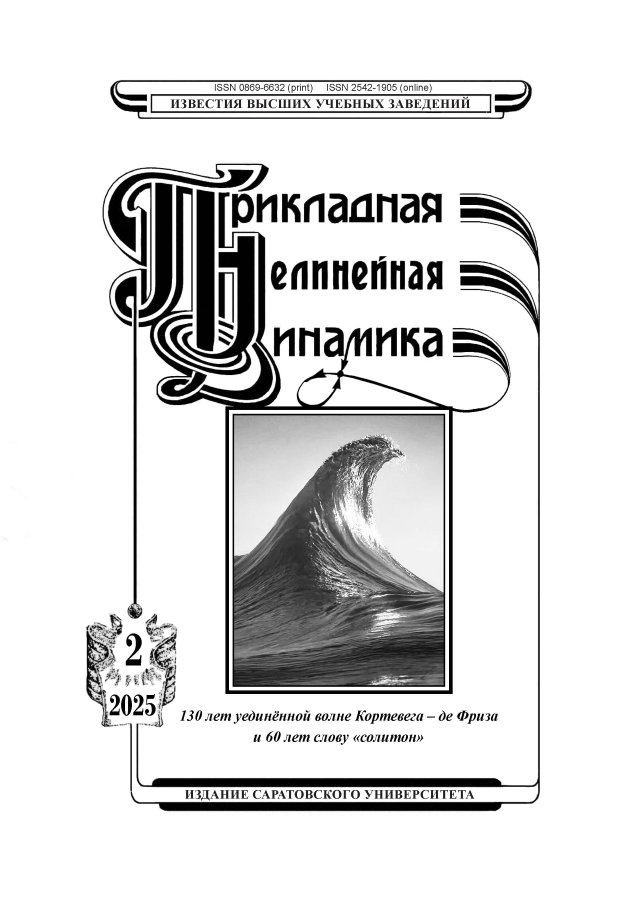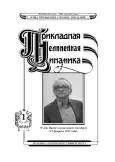Влияние «сенсорной предыстории» на обработку головным мозгом неоднозначных визуальных стимулов
- Авторы: Куц А.К.1,2, Максименко В.А.1,2,3, Храмов А.Е.1,2,3
-
Учреждения:
- Балтийский Федеральный Университет им. И. Канта
- Университет Иннополис
- Национальный исследовательский Нижегородский государственный университет имени Н. И. Лобачевского (ННГУ)
- Выпуск: Том 30, № 1 (2022)
- Страницы: 57-75
- Раздел: Статьи
- URL: https://journals.rcsi.science/0869-6632/article/view/251991
- DOI: https://doi.org/10.18500/0869-6632-2022-30-1-57-75
- ID: 251991
Цитировать
Полный текст
Аннотация
Об авторах
Александр Константинович Куц
Балтийский Федеральный Университет им. И. Канта; Университет Иннополисг. Калининград, ул. А.Невского, 14
Владимир Александрович Максименко
Балтийский Федеральный Университет им. И. Канта; Университет Иннополис; Национальный исследовательский Нижегородский государственный университет имени Н. И. Лобачевского (ННГУ)г. Калининград, ул. А.Невского, 14
Александр Евгеньевич Храмов
Балтийский Федеральный Университет им. И. Канта; Университет Иннополис; Национальный исследовательский Нижегородский государственный университет имени Н. И. Лобачевского (ННГУ)г. Калининград, ул. А.Невского, 14
Список литературы
- Rauss K., Pourtois G. What is bottom-up and what is top-down in predictive coding? // Frontiers in Psychology. 2013. Vol. 4. P. 276. doi: 10.3389/fpsyg.2013.00276.
- Teufel C., Fletcher P. C. Forms of prediction in the nervous system // Nature Reviews Neuroscience. 2020. Vol. 21, no. 4. P. 231-242. doi: 10.1038/s41583-020-0275-5.
- Kok P., Failing M. F., de Lange F. P. Prior expectations evoke stimulus templates in the primary visual cortex // Journal of Cognitive Neuroscience. 2014. Vol. 26, no. 7. P. 1546-1554. doi: 10.1162/jocn_a_00562.
- Kok P., Mostert P., de Lange F. P. Prior expectations induce prestimulus sensory templates // Proceedings of the National Academy of Sciences of the United States of America. 2017. Vol. 114, no. 39. P. 10473-10478. doi: 10.1073/pnas.1705652114.
- Teufel C., Dakin S. C., Fletcher P. C. Prior object-knowledge sharpens properties of early visual feature-detectors // Scientific Reports. 2018. Vol. 8, no. 1. P. 10853. doi: 10.1038/s41598-018- 28845-5.
- Heekeren H. R., Marrett S., Ungerleider L. G. The neural systems that mediate human perceptual decision making // Nature Reviews Neuroscience. 2008. Vol. 9, no. 6. P. 467-479. doi: 10.1038/nrn2374.
- Friston K. The free-energy principle: a rough guide to the brain? // Trends in Cognitive Sciences. 2009. Vol. 13, no. 7. P. 293-301. doi: 10.1016/j.tics.2009.04.005.
- Wacongne C., Labyt E., van Wassenhove V., Bekinschtein T., Naccache L., Dehaene S. Evidence for a hierarchy of predictions and prediction errors in human cortex // Proceedings of the National Academy of Sciences of the United States of America. 2011. Vol. 108, no. 51. P. 20754-20759. doi: 10.1073/pnas.1117807108.
- Henson R. N. A., Rugg M. D. Neural response suppression, haemodynamic repetition effects, and behavioural priming // Neuropsychologia. 2003. Vol. 41, no. 3. P. 263-270. doi: 10.1016/S0028- 3932(02)00159-8.
- Vogels R. Sources of adaptation of inferior temporal cortical responses // Cortex. 2016. Vol. 80. P. 185-195. doi: 10.1016/j.cortex.2015.08.024.
- Vinken K., Op de Beeck H. P., Vogels R. Face repetition probability does not affect repetition suppression in macaque inferotemporal cortex // Journal of Neuroscience. 2018. Vol. 38, no. 34. P. 7492-7504. doi: 10.1523/JNEUROSCI.0462-18.2018.
- Gilbert C. D., Li W. Top-down influences on visual processing // Nature Reviews Neuroscience. 2013. Vol. 14, no. 5. P. 350-363. doi: 10.1038/nrn3476.
- Schwiedrzik C. M., Freiwald W. A. High-level prediction signals in a low-level area of the macaque face-processing hierarchy // Neuron. 2017. Vol. 96, no. 1. P. 89-97. doi: 10.1016/j.neuron.2017.09.007.
- Maksimenko V., Kuc A., Frolov N., Kurkin S., Hramov A. Effect of repetition on the behavioral and neuronal responses to ambiguous Necker cube images // Scientific Reports. 2021. Vol. 11, no. 1. P. 3454. doi: 10.1038/s41598-021-82688-1.
- Maksimenko V. A., Frolov N. S., Hramov A. E., Runnova A. E., Grubov V. V., Kurths J., Pisarchik A. N. Neural interactions in a spatially-distributed cortical network during perceptual decision-making // Frontiers in Behavioral Neuroscience. 2019. Vol. 13. P. 220. doi: 10.3389/fnbeh.2019.00220.
- Maksimenko V. A., Runnova A. E., Zhuravlev M. O., Makarov V. V., Nedayvozov V., Grubov V. V., Pchelintceva S. V., Hramov A. E., Pisarchik A. N. Visual perception affected by motivation and alertness controlled by a noninvasive brain-computer interface // PLoS ONE. 2017. Vol. 12, no. 12. P. e0188700. doi: 10.1371/journal.pone.0188700.
- Kornmeier J., Friedel E., Wittmann M., Atmanspacher H. EEG correlates of cognitive time scales in the Necker-Zeno model for bistable perception // Consciousness and Cognition. 2017. Vol. 53. P. 136-150. doi: 10.1016/j.concog.2017.04.011.
- Hramov A. E., Maksimenko V. A., Pchelintseva S. V., Runnova A. E., Grubov V. V., Musatov V. Y., Zhuravlev M. O., Koronovskii A. A., Pisarchik A. N. Classifying the perceptual interpretations of a bistable image using EEG and artificial neural networks // Frontiers in Neuroscience. 2017. Vol. 11. P. 674. doi: 10.3389/fnins.2017.00674.
- Delorme A., Makeig S. EEGLAB: an open source toolbox for analysis of single-trial EEG dynamics including independent component analysis // Journal of Neuroscience Methods. 2004. Vol. 134, no. 1. P. 9-21. doi: 10.1016/j.jneumeth.2003.10.009.
- Павлов А. Н., Храмов А. Е., Короновский А. А., Ситникова Е. Ю., Макаров В. А., Овчинников А. А. Вейвлет-анализ в нейродинамике // УФН. 2012. Т. 182, № 9. С. 905-939. doi: 10.3367/UFNr.0182.201209a.0905.
- Hramov A. E., Koronovskii A. A., Makarov V. A., Maksimenko V. A., Pavlov A. N., Sitnikova E. Wavelets in Neuroscience. Cham: Springer, 2021. 384 p. doi: 10.1007/978-3-030-75992-6.
- Bakdash J. Z., Marusich L. R. Repeated measures correlation // Frontiers in Psychology. 2017. Vol. 8. P. 456. doi: 10.3389/fpsyg.2017.00456.
- Summerfield C., de Lange F. P. Expectation in perceptual decision making: neural and computational mechanisms // Nature Reviews Neuroscience. 2014. Vol. 15, no. 11. P. 745-756. doi: 10.1038/nrn3838.
- Tseng P., Iu K.-C., Juan C.-H. The critical role of phase difference in theta oscillation between bilateral parietal cortices for visuospatial working memory // Scientific Reports. 2018. Vol. 8, no. 1. P. 349. doi: 10.1038/s41598-017-18449-w.
- Berger B., Griesmayr B., Minarik T., Biel A. L., Pinal D., Sterr A., Sauseng P. Dynamic regulation of interregional cortical communication by slow brain oscillations during working memory // Nature Communications. 2019. Vol. 10, no. 1. P. 4242. doi: 10.1038/s41467-019-12057-0.
- Engel A. K., Fries P. Beta-band oscillations - signalling the status quo? // Current Opinion in Neurobiology. 2010. Vol. 20, no. 2. P. 156-165. doi: 10.1016/j.conb.2010.02.015.
- Okazaki M., Kaneko Y., Yumoto M., Arima K. Perceptual change in response to a bistable picture increases neuromagnetic beta-band activities // Neuroscience Research. 2008. Vol. 61, no. 3. P. 319-328. doi: 10.1016/j.neures.2008.03.010.
- Folstein J. R., Van Petten C. Influence of cognitive control and mismatch on the N2 component of the ERP: A review // Psychophysiology. 2008. Vol. 45, no. 1. P. 152-170. doi: 10.1111/j.1469- 8986.2007.00602.x.
- Nigbur R., Ivanova G., Sturmer B. Theta power as a marker for cognitive interference // Clinical Neurophysiology. 2011. Vol. 122, no. 11. P. 2185-2194. doi: 10.1016/j.clinph.2011.03.030.
- Wagner J., Wessel J. R., Ghahremani A., Aron A. R. Establishing a right frontal beta signature for stopping action in scalp EEG: Implications for testing inhibitory control in other task contexts // Journal of Cognitive Neuroscience. 2018. Vol. 30, no. 1. P. 107-118. doi: 10.1162/jocn_a_01183.
- Dehais F., Dupres A., Di Flumeri G., Verdiere K., Borghini G., Babiloni F., Roy R. Monitoring pilot’s cognitive fatigue with engagement features in simulated and actual flight conditions using an hybrid fNIRS-EEG passive BCI // 2018 IEEE International Conference on Systems, Man, and Cybernetics (SMC) / IEEE. New York, 2019. P. 544-549. doi: 10.1109/SMC.2018.00102.
- Gateau T., Ayaz H., Dehais F. In silico vs. over the clouds: On-the-fly mental state estimation of aircraft pilots, using a functional near infrared spectroscopy based passive-BCI // Frontiers in Human Neuroscience. 2018. Vol. 12. P. 187. doi: 10.3389/fnhum.2018.00187.
- Maksimenko V. A., Hramov A. E., Grubov V. V., Nedaivozov V. O., Makarov V. V., Pisarchik A. N. Nonlinear effect of biological feedback on brain attentional state // Nonlinear Dynamics. 2019. Vol. 95, no. 3. P. 1923-1939. doi: 10.1007/s11071-018-4668-1.
- Hramov A. E., Maksimenko V. A., Pisarchik A. N. Physical principles of brain-computer interfaces and their applications for rehabilitation, robotics and control of human brain states // Physics Reports. 2021. Vol. 918. P. 1-133. doi: 10.1016/j.physrep.2021.03.002.
Дополнительные файлы










